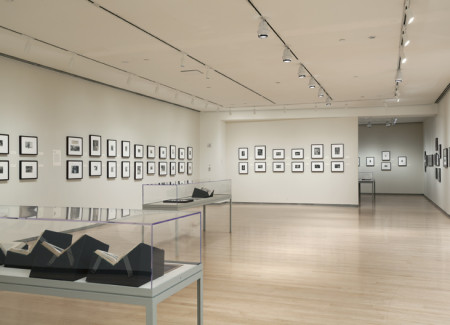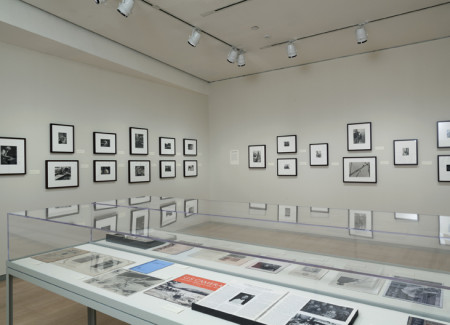JTF (just the facts): A total of 168 black and white photographs, framed in brown wood and matted, and hung against cream colored walls in a series of four interconnected spaces on the lower level of the museum. All of the works are gelatin silver prints, mostly vintage with a sprinkling of later/posthumous/modern prints, made between 1905 and 1937. The show also includes 8 glass cases filled with magazines and other ephemera. The material is on loan from the George Eastman House, and the exhibit was curated by Alison Nordström. (Installation shots below. ©International Center of Photography, 2013. Photographs by John Berens.)
This exhibit is divided into 10 sections, as follows:
Ellis Island
- 11 gelatin silver prints, 1905
Tenements
- 19 gelatin silver prints, 1905-1915
Child Labor
- 19 gelatin silver prints, 1906-1913
- 4 glass cases containing 16 pamphlets, bulletins, flyers and notebooks, with 16 open spreads, 8 posters, 1907-1917
The Pittsburgh Survey
- 13 gelatin silver prints, 1908-1910
- 1 glass case containing 7 books/spreads
Black America
- 9 gelatin silver prints, 1910-1920
- 1 glass case containing 1 magazine/1 spread, 1919, and 1 gelatin silver print (Hine at work), 1918
City Life
- 18 gelatin silver prints, 1910-1925
Europe
- 20 gelatin silver prints, 1918-1919
Work
- 30 gelatin silver prints, 1916-1935
Empire State Building
- 22 gelatin silver prints, 1929-1931
The Last Decade
- 7 gelatin silver prints, 1936-1937
- 2 glass cases containing 8 magazines, bulletins, and flyers, with 7 spreads, 1924-1940
A supporting exhibit entitled Lewis Hine’s New Deal Photographs is shown in an adjacent room. It includes 39 gelatin silver prints from 1936-1938 drawn from the ICP’s permanant collection, hung against orange walls.
Comments/Context: When we recall the work of the historical masters of photography, it is inevitable that we reduce their long and productive careers to a series of memorable thumbnails. It is the job of a well-edited retrospective to help us see more than just the landmarks and icons, but to follow the connections between each body of work and to trace the evolution of the underlying ideas that came forth as unforgettable images. In the case of Lewis Hine, my brain brings forth the girl in the cotton spinning mill, the shirtless mechanic with a wrench, the construction worker dangling from a wire above the girders of the Empire State Building and a few others with relative ease, but this show expands that story beyond the greatest hits to a four decade portrait of an artist continually walking the knife edge between sympathetic social documentary and muckraking propaganda.
Hine’s photographic journey began at Ellis Island, where he made pictures of weary European immigrants looking worn down and lost, drowning in their meager baggage. He then followed these people to the slums and tenements of the Lower East Side, where he chronicled the plight of large families crammed into one room, laundry hanging from the urban rooftops, and piece part work being done amid the poverty and squalor. As the many pamphlets and newsletters on display can attest, Hine’s transition to the issue of child labor brought with it much more attention. His images of miner boys, girls in textile mills, and kids of all kinds in canneries, factories, and farm fields took on a more symbolic tone, muddying the line between natural and posed for effect. Whether it was a newsboy selling papers or a child with a lost arm in a box factory, Hine was able to capture the overlooked injustice with quietly powerful emotion.
Over the next decade, Hine took on a variety of projects and subjects, never straying far from urban life. He documented the conditions surrounding the steel mills in Pittsburgh, the wooden houses and poverty of African Americans in the South, and the lively city vignettes of New York, from stick ball and box scooters, to beggars and employment offices. Following a stint in Europe just after World War I tracing the lives of refugees, he returned to the unassuming, everyday heroism of work as his primary interest, capturing a wide array of professions and occupations. Book stitchers and wig makers, grocery clerks and telephone operators, piano tuners and turbine electricians, all were seen in action, amid the tools of their trade and busy with their efforts. Seen together, the photographs are both a sociological taxonomy of a time gone by and a surprisingly romantic view of labor. This heroic perspective was amplified when Hine ultimately turned his camera to the construction of the Empire State Building, with its soaring beams, hoisting balls, and astonishingly precarious views of the city far below.
I came away from this exhibit with a more nuanced view of Hine, of the constant balance between his humanistic eye for the overlooked and forgotten and his need to make pictures that would energetically illustrate bulletins and flyers. We are never confused about Hine’s point of view; he is never ambiguous or deadpan. His pictures are the consistent work of an advocate, and seen across the breadth of an entire career, they seem to be a recurring search for a social reality worth exposing or celebrating.
Collector’s POV: As this is a museum show, there are of course no posted prices. Hine’s work is routinely available in the secondary markets, with prices in the past decade ranging from $1000 to over $200000 (with most prints finding buyers under $10000). That said, the Hine market was tainted by a forgery scandal roughly ten years ago, so collectors still need to be careful with claims of vintage authenticity.








